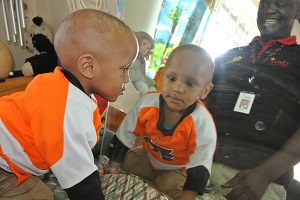Join a powerful, unprecedented alliance for better eye health for all.
Join IAPB-
Choose an alternate language here
The SIB Child Eye Health Programme for East Africa (SIB-CEHP/ EA) is in its third year of implementation and focuses on strengthening child eye care services in Uganda, Tanzania and Kenya.
The programme has established referral systems in targeted project locations across East Africa. A typical referral system has a village clinic as its starting point, where basic assessment is conducted on a child to determine if the eyes are fine. Identified cases of problems are referred to the next level, and then the next until a solution is found. Serious cases are taken up all the way to tertiary facilities that can perform surgeries, and post-operation follow-up activities. The established referral systems can now identify child eye-health problems at the earliest stages possible, and attend to them equally at the earliest level possible.

The programme is actively supporting the strengthening of Health Management Information Systems in each country, to be able to gather process and readily avail information on child eye health.
Financial sustainability
The design of the project concept for SiB-CEH/ EA ensured a heavy investment in human resource development and capital equipment for partner facilities. This support was built into the existing systems of these facilities to ensure streamlining and sustainability. Partner facilities have been offering eye health services using different financial sustainability models, with most of them adopting the cost-sharing method to help ensure future sustainability beyond the project life. In Kenya, the programme is starting to work with partner facilities, and the newly established National Health Insurance Fund, to forge a working arrangement where the fund will be paid directly to the facilities for any eye-care services provided.
Human Resource sustainability
The human resource component of the programme was developed based on identified capacity gaps. Personnel identified for training were mostly already employed by the respective facilities, hence would resume their jobs on completion of their training, but with improved skills and knowledge.
Going forward on sustainability, the programme has identified the need to keep developing eye health human resource in specialised areas like paediatric ophthalmology and retinoblastoma. Towards this objective, the programme is supporting the orientation of general ophthalmologists towards becoming specialised in paediatric ophthalmology, and other similar specialised areas. The programme engaged with the Ophthalmic Services Unit (OSU) at the Ministry of Health (MoH) to develop common ways of addressing the challenges faced. If it succeeds, this will contribute towards an increase in the number of specialised eye health personnel, allowing for their posting to respective counties and in the process taking such specialised services closer to those in need.
The programme has also been advocating for the allocation of a small percentage of the MoH budget towards eye-health. This involves bringing together key eye health stakeholders and technical staff at the MoH for the purposes of forging a common approach towards realising this dream. The success factor of this effort will be the institutionalization of a specified budget for eye-health, to begin with. Future advocacy efforts may then build on that foundation and push towards the increment of this budget gradually, over time.

CBM Regional Program Manager, Child Eye Health – “Seeing is Believing” Program